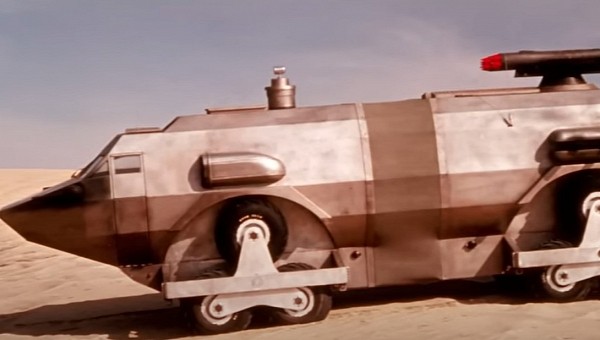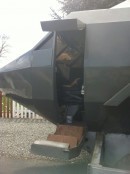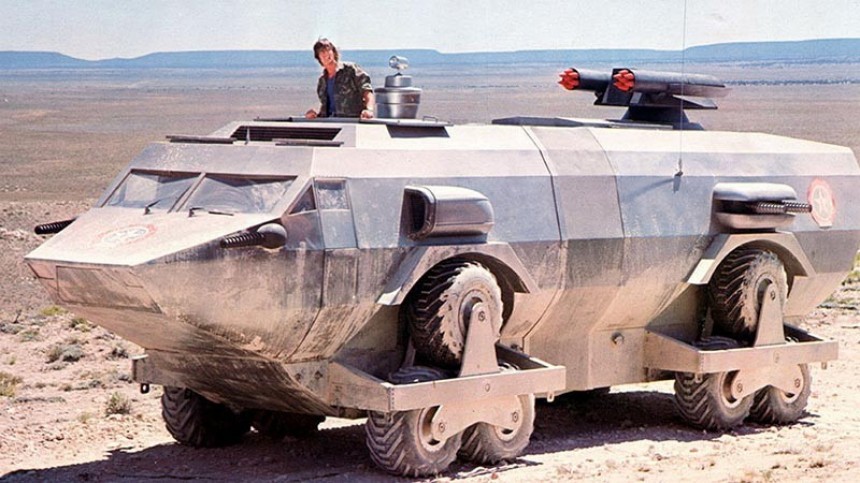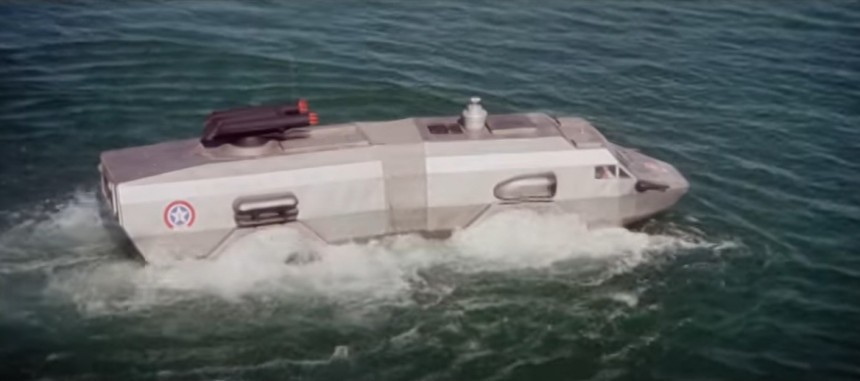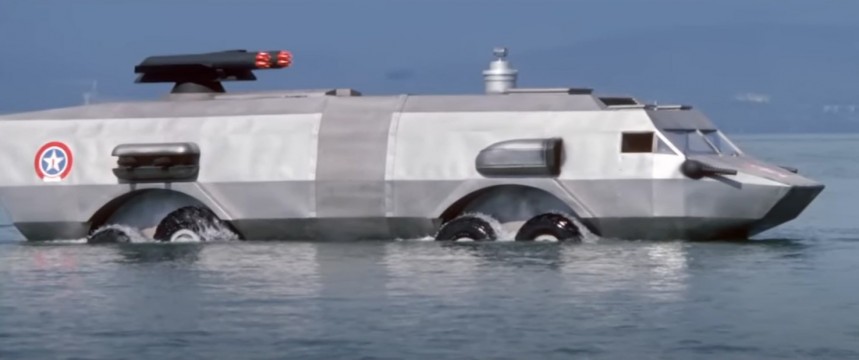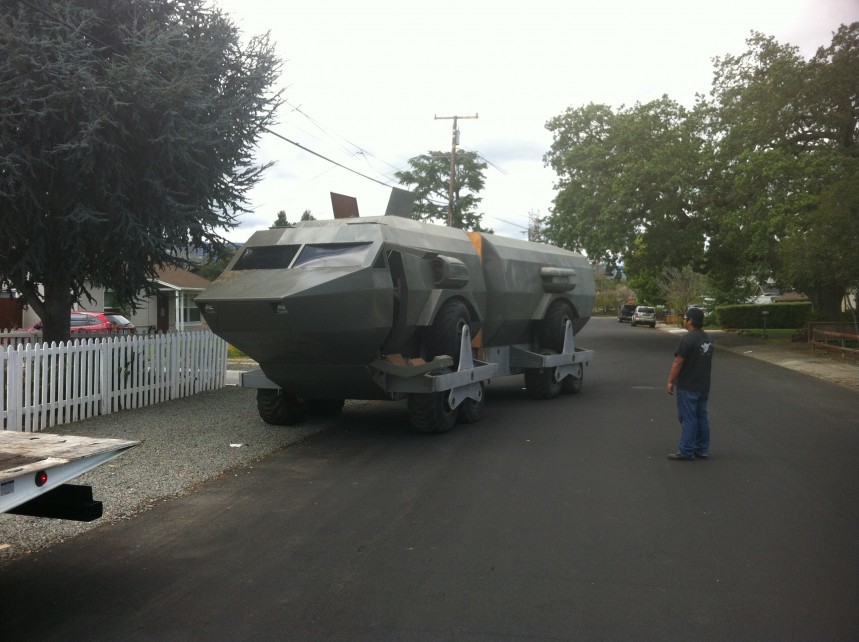Critics often complain that Hollywood productions are losing originality and, because of it, relying too much on CGI (computer-generated images) and virtual FX to compensate. That only becomes more apparent if you take a closer look at Landmaster, the most functional prop ever created, and an automotive icon on its own.
The Landmaster is perhaps the most famous movie vehicle, made so not necessarily by the movie it starred in, but by its very design and functionality. Designed and built entirely by Dean Jeffries at his California shop, it first made its appearance on the big screen in the now-cult classic, but then-box office flop Damnation Alley, which came out in 1977 and lost the summer box office race to Star Wars.
Damnation Alley is your typical post-apocalyptic movie of the era, in every sense of the word, good and bad. Based on the novel of the same name by Roger Zelazny, it is set after World War III. It tells the story of a small group of survivors, Air Force personnel at a nuclear launch site, who build two vehicles to help them cross the continent in the hope of finding other survivors. But the world has changed from how we know it, so that means they need something that would ensure their survival in extreme weather conditions, mutant creatures of all sorts (“KILLER COCKROACHES!!”), and the most treacherous terrain.
Only something like the Landmaster would do.
The Landmaster is actually a very real and very functional vehicle, built by Jeffries based on an initial sketch handed to him by producers at 20th Century Fox. At the time, Jeffries was already a go-to guy in the industry: a self-taught stuntman, mechanic, car customizer, and pinstriper, he had worked in George Barris’ shop and boasted a portfolio of movie vehicles that included the Monkeemobile, the moon buggy James Bond steals in Diamonds Are Forever, and Black Beauty in the Green Hornet TV series. He was also the man who painted “Little Bastard” on James Dean’s Porsche 550 Spyder, at Dean’s request.
As Jeffries would recall in one of his last interviews (he passed away in 2013), producers told him they wanted a vehicle that would handle rough terrains with ease, that could travel through swamps and float on water, which could ram walls, and look like it could survive anything a post-apocalyptic world threw at it and its inhabitants. Based on this brief and the only sketch he was presented with, Jeffrey drew his own interpretation of the vehicle: a 35-foot long, 11-foot wide, and 12-foot tall (10.6 x 3.3 x 3.6 meters) articulated rig like no other before it.
The Landmaster used a chassis a military contractor had donated to the movie studio and a patented military invention that had never been put into practice, for a system of 12 wheels arranged in triangular sets, which would give the rig its unique all-terrain and amphibious capabilities. It took Jeffries close to three months and between $350,000 and $500,000 (so between $1.7 million and $2.5 million in today’s money) to complete the project. Even though two vehicles are shown in the film, only one was built – and it’s still around today, though it has seen far better days.
The highlight of the rig was the tri-star wheel arrangement. Each set of wheels was independently driven and could be operated locked or unlocked. In the former position, only 8 wheels of the 12 touched the ground at any time; in the latter, the top wheel would automatically rotate into position when the rig came across an obstacle, forcing the rig over or through it.
According to Jeffries, this meant that the Landmaster could easily crawl over rocks and through deep holes, and even do very high jumps (25 feet or 7.6 meters) at a speed of 55 mph (88.5 kph), and take no damage. With a body of steel, sheet metal and aluminum, it was virtually indestructible, and Jeffries said that the only problem with it during the very difficult production for Damnation Alley was when they got a flat tire on one of the wheel arrangements.
The rig didn’t have any shocks or springs, but remained an equally comfortable ride regardless of the terrain it was crossing. And despite its weight of over 11 tons, it could float on water, using the same wheel system for paddling for a maximum speed of 8 knots (9.2 mph / 14.8 kph). However, Jeffries would later recall that the scene in which it’s shown floating on Flat Head Lake, Montana was the most challenging to shoot.
The movie version featured a state-of-the-art cockpit, twin bunks, a shower, and a bathroom, as well as a radar scanner, CCTV, six remote-operated cannons, a pair of armor-piercing bazookas, and a cylindrical antenna. The real thing had a very bare interior, since all interior scenes were shot in the studio. The launcher and the antenna on the roof were props, but apparently, at some point, the machine guns were real and were replaced with props for other scenes.
The Landmaster steered by bending in the middle, much like a large construction rig. The articulated section included hydraulic rams allowing the rig to turn 30 degrees; it would make a full circle in 35 feet (10.6 meters). It rode on farm-equipment tires, Goodyear Super Terra-Grips 38 inches in diameter and 24 inches wide, mounted on custom 16.1-inch wheels. When it was last seen in motion in 2014, the Landmaster could still move under its own power and still had the original tires.
Speaking of power, it came from a 1974 931-cubic-inch, 6.4-liter Ford engine mated to an Allison transmission, with headers by Cragar and an intake manifold by Edelbrock. Urban legend has it that Jeffries had sourced two such powerplants from Carroll Shelby, with whom he had worked on the Cobra, and that the second one was accidentally scrapped after Jeffries’ death.
Some years before Jeffries’ death, the builder agreed to sell the Landmaster, after realizing he had done all there could be done with it.
After Damnation Alley, the Landmaster made a handful of other appearances in small-budget TV movies and TV commercials, with Jeffries tweaking its exterior and giving it fresh paint jobs to avoid too striking a similarity to the original, now-iconic appearance. He kept it outside his shop in North Hollywood until 2005, when he sold it to a private collector, who, in turn, restored it to its original condition, and took it on the road at car and movie displays across the country.
Vandalized in storage in the late aughts, the Landmaster was moved to another location in 2014, and then, in 2016, relocated to Gene Winfield’s Custom Shop on Sierra Highway between Rosamond, California and Mojave, California. It was there in 2019, and it is believed it’s still there today, though it’s not open to the public and, exposed to the elements, is probably in a far worse condition than before.
That last part is perhaps the saddest. The Landmaster is not just Hollywood’s most functional (and awesome) movie prop, but a true legend, harkening back to a time when film production involved creative thinking and a true artist’s touch. It deserves better.
Damnation Alley is your typical post-apocalyptic movie of the era, in every sense of the word, good and bad. Based on the novel of the same name by Roger Zelazny, it is set after World War III. It tells the story of a small group of survivors, Air Force personnel at a nuclear launch site, who build two vehicles to help them cross the continent in the hope of finding other survivors. But the world has changed from how we know it, so that means they need something that would ensure their survival in extreme weather conditions, mutant creatures of all sorts (“KILLER COCKROACHES!!”), and the most treacherous terrain.
Only something like the Landmaster would do.
As Jeffries would recall in one of his last interviews (he passed away in 2013), producers told him they wanted a vehicle that would handle rough terrains with ease, that could travel through swamps and float on water, which could ram walls, and look like it could survive anything a post-apocalyptic world threw at it and its inhabitants. Based on this brief and the only sketch he was presented with, Jeffrey drew his own interpretation of the vehicle: a 35-foot long, 11-foot wide, and 12-foot tall (10.6 x 3.3 x 3.6 meters) articulated rig like no other before it.
The Landmaster used a chassis a military contractor had donated to the movie studio and a patented military invention that had never been put into practice, for a system of 12 wheels arranged in triangular sets, which would give the rig its unique all-terrain and amphibious capabilities. It took Jeffries close to three months and between $350,000 and $500,000 (so between $1.7 million and $2.5 million in today’s money) to complete the project. Even though two vehicles are shown in the film, only one was built – and it’s still around today, though it has seen far better days.
The highlight of the rig was the tri-star wheel arrangement. Each set of wheels was independently driven and could be operated locked or unlocked. In the former position, only 8 wheels of the 12 touched the ground at any time; in the latter, the top wheel would automatically rotate into position when the rig came across an obstacle, forcing the rig over or through it.
The rig didn’t have any shocks or springs, but remained an equally comfortable ride regardless of the terrain it was crossing. And despite its weight of over 11 tons, it could float on water, using the same wheel system for paddling for a maximum speed of 8 knots (9.2 mph / 14.8 kph). However, Jeffries would later recall that the scene in which it’s shown floating on Flat Head Lake, Montana was the most challenging to shoot.
The movie version featured a state-of-the-art cockpit, twin bunks, a shower, and a bathroom, as well as a radar scanner, CCTV, six remote-operated cannons, a pair of armor-piercing bazookas, and a cylindrical antenna. The real thing had a very bare interior, since all interior scenes were shot in the studio. The launcher and the antenna on the roof were props, but apparently, at some point, the machine guns were real and were replaced with props for other scenes.
The Landmaster steered by bending in the middle, much like a large construction rig. The articulated section included hydraulic rams allowing the rig to turn 30 degrees; it would make a full circle in 35 feet (10.6 meters). It rode on farm-equipment tires, Goodyear Super Terra-Grips 38 inches in diameter and 24 inches wide, mounted on custom 16.1-inch wheels. When it was last seen in motion in 2014, the Landmaster could still move under its own power and still had the original tires.
Some years before Jeffries’ death, the builder agreed to sell the Landmaster, after realizing he had done all there could be done with it.
After Damnation Alley, the Landmaster made a handful of other appearances in small-budget TV movies and TV commercials, with Jeffries tweaking its exterior and giving it fresh paint jobs to avoid too striking a similarity to the original, now-iconic appearance. He kept it outside his shop in North Hollywood until 2005, when he sold it to a private collector, who, in turn, restored it to its original condition, and took it on the road at car and movie displays across the country.
That last part is perhaps the saddest. The Landmaster is not just Hollywood’s most functional (and awesome) movie prop, but a true legend, harkening back to a time when film production involved creative thinking and a true artist’s touch. It deserves better.
